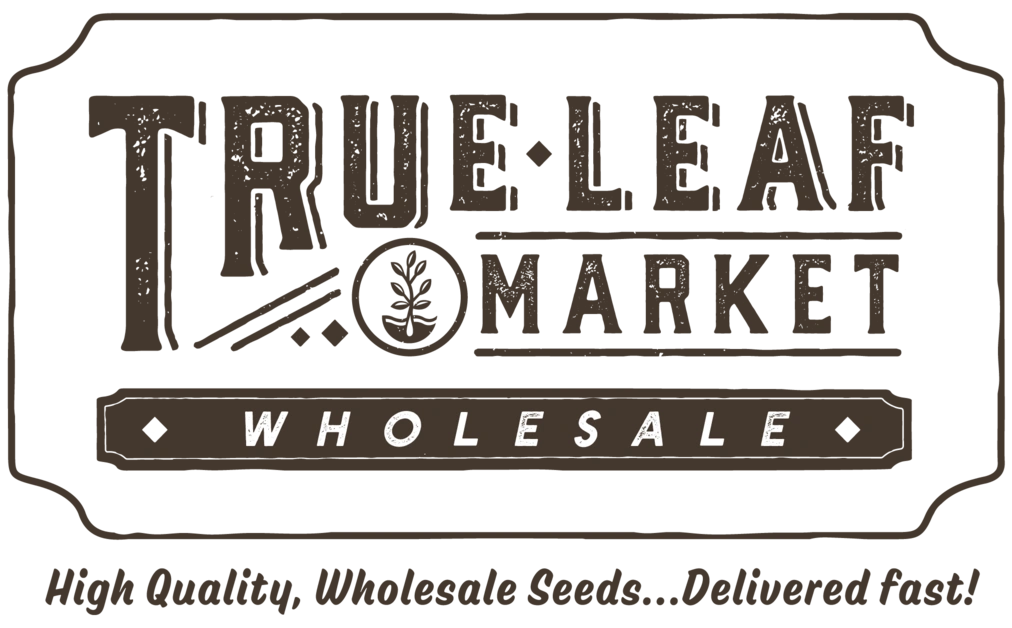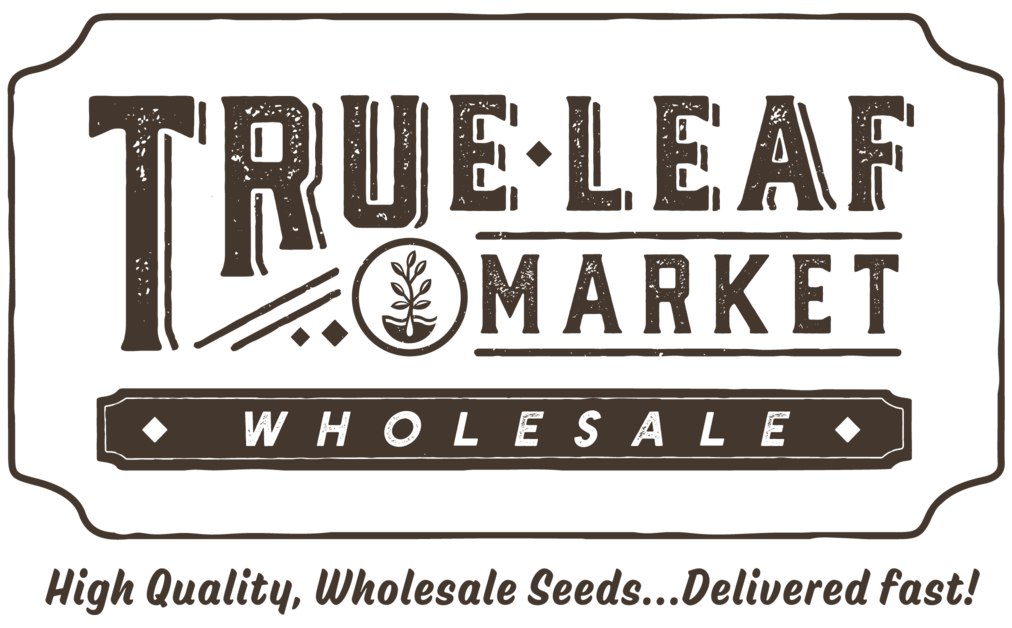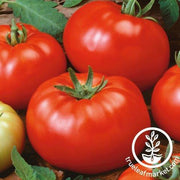Tomato Seeds - Slicing - Brandywine Red
80-100 Days to maturity (from transplant). Solanum lycopersicum. Brandywine Red Tomato Seeds. Non-GMO, annual, regular leaf, open-pollinated, heirloom, indeterminate, slicing tomato. Suitable for growing in garden plots, raised beds, and greenhouses. Resistant to Early Blight, and Fulvia Blight. This old-fashioned, excellent sweet tomato is a popular Amish heirloom variety that dates back to 1885. It was named after Brandywine Creek in Chester County PA. It develops large indeterminate vines that yield large slicing tomatoes of 8-12 oz. ~6,800 seeds/oz.
Download Free Vegetable Growing Guide PDF
Growing Brandywine Red Regular Leaf Tomatoes in the Vegetable Garden
In most areas, tomatoes are best started indoors and transplanted outside. About 6-8 weeks before the last spring frost, use well-draining potting soil to start the seeds. Plant 2 or 3 seeds in each cell a quarter inch deep. Water the seeds. The seedlings should be kept warm and moist, emerging in 7-10 days. We recommend using a heat mat to start tomato seeds indoors. At the first sign of germiantion, promptly move them to direct sunlight or provide a grow light. They should receive 8-16 hours of light. Once the seedlings are 1-2 inches tall, thin them so there is only one strong seedling per cell.
When they have developed two true leaves, fertilize with a mild fertilizer. When the seedlings have grown to fill the cell with their roots, transplant them into 6-inch pots. Around two weeks before their predicted transplant date, gradually acclimate them to their new environment. Leave them outdoors for a few hours during the warmest part of each day, adding a few more hours each day as you get closer to the transplant date. Keep them indoors at night or if temperatures are expected to drop. Once temperatures are consistently around 70 F, transplant the seedlings outdoors. Tomato plants are warm weather lovers and should be shielded from temperatures below 50 F.
Provide Brandywine with loamy, well-drained, slightly acidic soil. Adding compost to the soil is a great way to increase water retention and nutrient density. The tomato plants must receive full sun and warm temperatures. When planting, make sure to bury them about two-thirds deep. The buried portion of the stem will develop roots, resulting in a sturdier transplant. Apply an even fertilizer at the time of transplanting.
Throughout the season, prune the plant by removing suckers (new shoots that form between the stem and horizontal branches) and bottom leaves. Doing this helps the plant focus on fruiting. Tomato plants should receive full sun throughout the season to fruit and thrive. Fertilize again about halfway through the season. Water them in the morning if possible, and avoid splashing the leaves.
Harvesting Brandywine Red Tomatoes
This indeterminate variety will continuously produce fruit until it dies. As soon as the tomatoes are ripe, they should be picked. Being quick about it avoids overburdening the plant and encourages more fruit development. Harvest the fruit when it is red, shiny, and firm. Gently twist or snip the tomato to remove it from the vine. If you know that an impending frost might kill your plant, harvest the rest of the fruit, regardless of ripeness, and continue ripening them indoors.
About Brandywine Red Regular Leaf Tomato Garden Seeds
Tomatoes grown from Brandywine Red tomato seeds are beefsteaks. Fresh from the vine, they are prized for their sandwich-sized slicers with a delicious flavor. They also pair well in salads with other fresh garden produce. Brandywine Red tomatoes may be cooked, canned, frozen, or dried like any other tomato.
These indeterminate plants grow up to 8 feet tall, so staking is necessary. Brandywine Red tomatoes ripen about 70 days after transplanting, resulting in large, round fruits.
Tomatoes of all shapes and varieties are vitamin-rich, delivering the body much-needed vitamins B, C, K, and the important potassium. Brandywine Red tomatoes contain lycopene, an antioxidant associated with reduced risk of macular degeneration and prostate and colon cancers. It's been suggested that the vitamin B can reduce high cholesterol and high blood pressure. A more homeopathic application uses pulped tomatoes as a homemade wash for oily skin.
A true classic, these giant red tomatoes languished in obscurity on a single farm in rural Ohio for over 80 years. Then another gardener realized its potential, and the Brandywine Red seeds gained popularity and finally became commercially available in 1982. Popular for its excellent exotic flavor, these soft-textured giants have a creamy smooth flesh. Make sure you have a sturdy collection basket though as these whoppers weigh up to 12 ounces!
Tips From Our Gardeners
"If you are new to the tomato game, you have to try Brandywine! It will blow you away compared to the typical grocery store tomato."
 |
- Lara Wadsworth, True Leaf Market Writer |
Other Resources
Brandywine Red Tomato Seeds Per Package:
- 250 mg - Approximately 90 Seeds
- 0.25 oz - Approximately 2,500 Seeds
- 1 oz - Approximately 10,000 Seeds
- 4 oz - Approximately 40,000 Seeds
- 1 lb - Approximately 160,000 Seeds
Non-GMO Brandywine Red Tomato seeds are available for Fast Free Shipping on qualifying orders.
Basic Info
| Latin Name: | Solanum lycopersicum (Previously Lycopersicon esculentum, however this name is no longer accepted as correct) |
| Tomato Type: | Slicing - Larger, round tomatoes, the size of your fist or larger. |
| Brandywine Red Tomato Color: | Red |
| Brandywine Red Tomato Flavor: | Old-fashioned, sweet |
Growing Info
| Hardiness Zone: | 2, 3, 4, 5, 6, 7, 8, 9, 10, 11 Annual: Not intended to overwinter |
| Days to Maturity: | 80-100 (from transplant) |
| Days to Germination: | 7-10 |
| Seeding Depth: | 0.25 inch |
| Plant Spacing: | 24-36 inches |
| Row Spacing: | 36 inches |
| Plant Height: | 36-96 inches |
| Growth Habit: | Indeterminate - Indeterminate tomatoes are vine-type plants that sprawl (requiring a cage or trellis to support them) and continue to grow throughout the season. Indeterminate tomato plants will continue to produce tomatoes for the rest of the season, so you can harvest continually. |
| Soil Preference: | Well-draining, loose (sandy loam), slightly acidic (6.2 to 6.8), and moisture retaining. Too much nitrogen in the soil may lead to more foliage production and less fruiting. Tomatoes like more phosphorus and potassium than other vegetables. |
| Temperature Preference: | Warmer (70-85 F) |
| Light Preference: | Full Sun |
Other
| Direct Sow: | No |
| Start Indoors: | Yes. Start Indoors 6-8 weeks before your last spring frost date. |
| Plant Width: | 24 inches |
| Plant Spread: | 24 inches |
| Growth Speed: | Late - Ready to harvest from 81 days or more from transplant. Difficult, if not impossible, to get a tomato by the 4th of July with these varieties. They are good late-summer to early-fall producers for most USDA Zones. |
| Germination Temperature: | 65-85 F |
| Pests and Diseases: | Resistant to Early Blight, and Fulvia Blight. Common pests known to harm tomato plants, in general, include the tomato hornworm, cutworm, aphids, flea beetles, tomato fruit worms, and whiteflies. Also, watch for common diseases such as blossom end rot, fusarium wilt, powdery mildew, verticillium wilt, late blight, bacterial canker/spot, and tobacco mosaic virus. Most of these can be prevented by maintaining a regular watering schedule and avoiding overwatering. Regularly check your plants for pest damage throughout the season. For treating pest and disease problems, we recommend using an organic neem-based product. |
| Garden Size: | Greenhouse, Garden Plot, Raised Bed |
| Tomato Use: | Salads, fresh eating, large slicing, sandwiches |





